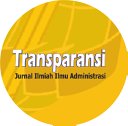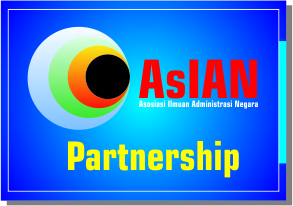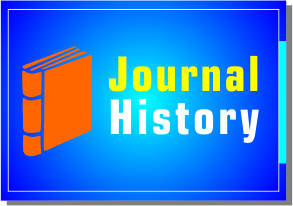Tata Kelola Kota Layak Anak: Sebuah Analisis Bibliometrik
DOI:
https://doi.org/10.31334/transparansi.v6i1.3131Keywords:
Governance, Child-Friendly City, Bibliometrics Analysis, VOSViewer,Abstract
This study aims to analyze the scientific literature on child-friendly city governance using the Bibliometric Analysis framework. Analysis using VOSviewer software version 1.6.19 with database from Google Scholar. The search for articles uses Publish or Perish software version 8, assisted by the Mendeley Desktop software version 1.19.8 in completing the article data. The keywords used in the search were "governance" and "child-friendly cities." By using these keywords, 307 article documents obtain. The articles were sorted and eliminated in two stages, resulting in 29 documents. Furthermore, literature analysis carries out in four parts: publication analysis, institutional contribution analysis, citation analysis, and keyword analysis. In general, the results show that in recent years there has been an increase in the scientific literature on the theme of child-friendly urban governance. However, these articles and annual citations still need to be higher. In addition, published articles can group into five clusters of research themes.References
G. P. Gonibala, J. Waani, and L. Rompas, “Evaluasi Pelaksanaan Kota Layak Anak dalam Penyediaan Infrastruktur (Prasarana Dan Sarana) Ramah Anak Di Kota Kotamobagu,†Fraktal, vol. 7, no. 2, 2022.
H. Patilima, “Kota Layak Anak,†2017. https://www.kla.id/kota-layak-anak/.
H. Fajri et al., “Peningkatan Keterlibatan Stakeholder Dalam Perumusan Peraturan Nagari Layak Anak,†Din. J. Pengabdi. Kpd. Masy., vol. 4, no. 4, pp. 754–761, 2020, doi: 10.31849/dinamisia.v4i4.4550.
F. D. Fiqri and H. Fajri, “Kapasitas Forum Anak Dalam Mengadvokasi Kepentingan Anak Di Dalam Program Kota Layak,†Masamus J. Public Adm., vol. 5, no. 2, 2023.
N. Wahyuni, M. Jamilah, and H. Fajri, “Power Sharing Stakeholder of Child-Friendly City Task Force,†J. Public Policy, vol. 8, no. 1, p. 11, 2022, doi: 10.35308/jpp.v8i1.4451.
N. Wahyuni, R. F. Helmi, and H. Fajri, “Child-Friendly City: Failure To Build Collaboration,†J. El-Riyasah, vol. 12, no. 2, pp. 159–170, 2021.
N. Donthu, S. Kumar, D. Mukherjee, N. Pandey, and W. M. Lim, “How to conduct a bibliometric analysis: An overview and guidelines,†J. Bus. Res., vol. 133, no. March, pp. 285–296, 2021, doi: 10.1016/j.jbusres.2021.04.070.
J. M. Merigó and J. B. Yang, “A bibliometric analysis of operations research and management science,†Omega (United Kingdom), vol. 73, pp. 37–48, 2017, doi: 10.1016/j.omega.2016.12.004.
M. Gaviria-Marin, J. M. Merigo, and S. Popa, “Twenty years of the Journal of Knowledge Management: a bibliometric analysis,†J. Knowl. Manag., vol. 22, no. 8, pp. 1655–1687, 2018, doi: 10.1108/JKM-10-2017-0497.
N. Donthu, S. Kumar, and D. Pattnaik, “Forty-five years of Journal of Business Research: A bibliometric analysis,†J. Bus. Res., vol. 109, no. October 2019, pp. 1–14, 2020, doi: 10.1016/j.jbusres.2019.10.039.
N. Ye, T. B. Kueh, L. Hou, Y. Liu, and H. Yu, “A bibliometric analysis of corporate social responsibility in sustainable development,†J. Clean. Prod., vol. 272, p. 122679, 2020, doi: 10.1016/j.jclepro.2020.122679.
I. Widianingsih, C. Paskarina, R. Riswanda, and P. B. Putera, “Evolutionary Study of Watershed Governance Research: A Bibliometric Analysis,†Sci. Technol. Libr., vol. 40, no. 4, pp. 416–434, 2021, doi: 10.1080/0194262X.2021.1926401.
E. Laksmi and R. Haryanti, “Corporate Social Responsibility in Preventing Child Marriage In Indonesia: Systematic Literature Review 2016 - 2021,†2022, doi: 10.4108/eai.15-9-2021.2315191.
R. Rifandini, B. P. T. Putri, and A. F. Sholakodin, “Analisis Model Mekanisme Partisipasi Forum Anak dalam Pembangunan Sosial: Suatu Pendekatan SSM,†Transformative, vol. 9, no. 1, pp. 102–126, 2023, doi: 10.21776/ub.transformative.2023.009.01.6.
F. Pujianti, E. A. Muhtar, and T. Setiawan, “Jejaring Kebijakan Dalam Pelaksanaan Kebijakan Kota Layak Anak (Kla) Melalui Perogram Perlindungan Dan Penanganan Korban Kekerasan Terhadap Anak Di Kota Bandung,†JANE - J. Adm. Negara, vol. 14, no. 1, p. 457, 2022, doi: 10.24198/jane.v14i1.41373.
Z. A. Karim, S. Mukhlis, N. U. Siam, and F. Awalia, “Implementasi Tata Kelola Pemerintahan Dalam Penanggulangan Kekerasan Terhadap Anak Di kabupaten Bintan,†JISIPOL J. Ilmu Sos. dan Polit. Raja Haji, vol. 4, no. 2, pp. 1069–1078, 2023.
P. Arpani and M. El Muhtaj, “Sekolah Ramah Anak Pada Peserta Didik Penyandang Disabilitas Tunagrahita (Studi Kasus Sekolah Luar Biasa Melati Aisyiah Kabupaten Deli Serdang),†J. Kewarganegaraan, vol. 20, no. 1, 2023, [Online]. Available: https://jurnal.unimed.ac.id/2012/index.php/jk/article/view/43026.
A. I. Sari and Z. Rusli, “Tata Kelola Pemerintahan Dinamis (Dynamic Governance) Dalam Penyelenggaraan Kota Layak Anak Di Kota Pekanbaru,†J. Adm. Publik, vol. 5, no. 1, 2023.
D. S. Utari, D. Arfa, R. Rianto, and R. A. Matridi, “The Development of Human Resources Capacity on Children’s Forum in Tanjungpinang City Throught ‘Becoming Z Generation Researcher’ Workshop,†Mattawang J. Pengabdi. Masy., vol. 3, no. 4, pp. 464–472, 2022, doi: 10.35877/454ri.mattawang1183.
N. D. Permatasari and E. R. Nawangsari, “Pemberdayaan Anak Jalanan Oleh Komunitas ‘Save Street Child’ Di Kabupaten Sidoarjo,†J. Sos. Ekon. …, vol. 8, no. 3, 2022, [Online]. Available: http://www.jseh.unram.ac.id/index.php/jseh/article/view/118.
M. Mahmuddin and M. Mansari, “Jejaring Komunikasi Collaborative Governance: Arah Perlindungan dan Kesejahteraan Sosial Anak di Aceh,†J. Sosiol. USK (Media Pemikir. Apl., vol. 16, no. 2, pp. 186–203, 2022, doi: 10.24815/jsu.v16i2.25906.
M. A. Latif, M. H. Rosyidi, and R. Khoiriah, “Sekolah Ramah Anak Berintegritas Pesantren,†Ummul Qura J. Inst. …, vol. 16, no. 1, 2021, [Online]. Available: https://www.ejournal.insud.ac.id/index.php/UQ/article/view/537.
I. P. Pratiwi and Rury, “Collaborative Governance Dalam Perlindungan Anak Kota Pekanbaru Tahun 2017-2019,†J. Online Mhs., vol. 8, no. 1, 2021.
Elmayanti and M. A. Rauf, “Model Pendekatan Desa Adat Dalam Pencegahan Tindak Pidana Kekerasan Pada Anak di Wilayah Pesisir Kabupaten Siak,†Riau Law J., vol. 5, no. 2, pp. 194–214, 2021.
N. Wahyuni, R. F. Helmi, and A. D. Akmal, “Advokasi Pembentukan Forum Anak Nagari,†Abdi J. Pengabdi. dan …, vol. 3, no. 2, 2021, [Online]. Available: http://abdi.ppj.unp.ac.id/index.php/abdi/article/view/109.
J. J. B. Beliu and Y. N. Fina, “Kajian Terhadap Kebijakan Perlindungan Hak Anak Di Kabupaten Timor Tengah Selatan,†JIAPI J. Ilmu Adm. Dan Pemerintah. …, 2021, [Online]. Available: http://www.jiapi.ut.ac.id/index.php/jiapi/article/view/62.
P. Supriatna, I. E. Jumiati, and A. Budiati, “Perencanaan Strategis DP3AKKB Provinsi Banten Dalam Pencegahan Kekerasan Terhadap Anak Studi Kasus Program PATBM,†JIPAGS (Journal …, vol. 5, no. 1, 2021, [Online]. Available: https://jurnal.untirta.ac.id/index.php/JIPAGS/article/view/9633.
K. Hadi and P. Purwanto, “Pendidikan Ramah Anak Berbasis Kurikulum Syariah di SD Muhammadiyah Program Khusus Kota Barat Surakarta,†An-Nizom, vol. 6, no. 2, pp. 78–87, 2019.
S. Amalia and I. D. A. Nurhaeni, “Komunikasi dan Disposisi Penanganan Kekerasan Pada Perempuan dan Anak: Studi Kasus Pada Pelayanan Terpadu Perempuan dan Anak Kota Surakarta,†J. Mhs. Wacana Publik, vol. 1, no. 2, 2021, [Online]. Available: https://jurnal.uns.ac.id/wacana-publik/article/view/54602.
I. N. Inayati, A. Rofik, U. Islam, R. Rahmat, and ..., “Konstruksi budaya damai berbasis manajemen kesiswaan dalam model sekolah ramah anak,†Al-Wijdan, vol. V, no. 1, 2020, [Online]. Available: http://ejournal.uniramalang.ac.id/index.php/alwijdan/article/view/474.
N. Annisa and Z. Alhadi, “Evaluasi Pelaksanaan Kota Layak Anak Dalam Penyediaan Infrastruktur (Sarana Dan Prasarana) Ramah Anak Di Kota Padang,†J. Manaj. dan Ilmu Adm. Publik, vol. 2, no. 1, pp. 68–74, 2019, doi: 10.24036/jmiap.v1i2.21.
I. N. Inayati and R. Trianingsih, “Relevansi Pendekatan Pembelajaran Tematik Integratif Di Sd/Mi Dengan Konsep Madrasah/Sekolah Ramah Anak,†Tarbiyatuna Kaji. Pendidik. Islam, vol. 3, no. 2, p. 139, 2019, doi: 10.29062/tarbiyatuna.v3i2.264.
A. D. Sucia and A. I. Iqbal, “Implementasi Ruang Publik Terpadu Ramah Anak (RPTRA) Di RPTRA Sunter Jaya Berseri, Kelurahan Sunter Jaya, Jakarta Utara,†J. Gov., vol. 5, no. 1, 2019.
Fahrunnisa and Apriadi, “Kesiapan Kabupaten Sumbawa Menjadi Kabupaten Layak Anak (Ditinjau dari Aspek Penguatan Kelembagaan dan Implementasi Pemenuhan Hak Anak),†J. TAMBORA, vol. 3, no. 3, pp. 72–77, 2019, doi: 10.36761/jt.v3i3.399.
H. Sudrajat and B. Tamara, “Peran Naskah Akademik Dan Daftar Inventarisasi Masalah Dalam Mewujudkan Peraturan Daerah Nomor 2 Tahun 2015 Tentang Perlindungan Anak Yang Aspiratif Di Kota Tanggerang,†Soumatera Law Rev., vol. 1, no. 2, pp. 282–297, 2018.
D. Roza and L. A. S, “Peran Pemerintah Daerah Di Dalam Melindungi Hak Anak Di Indonesia,†Masal. Huk., vol. 47, no. 1, 2018, doi: 10.14710/mmh.47.1.2018.10-21.
S. Zumaroh and W. Widodo, “Pendidikan Ramah Anak Berbasis Kurikulum Syariah Di Sd Muhammadiyah Program Khusus Kotta Barat Surakarta,†Edudeena, vol. 2, no. 2, pp. 173–179, 2018, doi: 10.30762/ed.v2i2.723.
N. Duadji and N. Tresiana, “Kota Layak Anak Berbasis Collaborative Governance,†Sawwa J. Stud. Gend., vol. 13, no. 1, 2018, [Online]. Available: https://journal.walisongo.ac.id/index.php/sawwa/article/view/2201.
S. Samsuddin, “Analisis Pengaruh Pelaksanaan Program Kota Layak Anak Klaster Kesehatan terhadap Pelayanan Kesehatan Anak Usia 0-59 Bulan,†Heal. Inf. J. Penelit., vol. 9, no. 1, pp. 1–9, 2017, doi: 10.36990/hijp.v9i1.64.
A. Yulianto, “Pendidikan Ramah Anak Studi Kasus SDIT Nur Hidayah Surakarta,†At-Tarbawi J. Kaji. Kependidikan …, vol. 1, no. 2, 2016, [Online]. Available: http://ejournal.iainsurakarta.ac.id/index.php/at-tarbawi/article/view/192.
M. I. Haq, “Quo Vadis Partisipasi Masyarakat Dalam Kebijakan Kabupaten Layak Anak (KLA) Sleman,†Apl. J. Apl. Ilmu-ilmu Agama, vol. 16, no. 2, 2016, [Online]. Available: https://ejournal.uin-suka.ac.id/pusat/aplikasia/article/view/1172.
R. Subiyakto, “Membangun kota layak anak: Studi kebijakan publik di era otonomi daerah,†Sosio Relig., vol. 10, no. 1, 2012, [Online]. Available: https://www.academia.edu/download/35597581/revisi_no_04._membangun_kota_ramah_anak_penulis_rudi_subiyakto.pdf.
Downloads
Published
Issue
Section
License

This work is licensed under a Creative Commons Attribution-ShareAlike 4.0 International License
Please find the rights and licenses in Transparansi : Jurnal Ilmiah Ilmu Administrasi By submitting the article/manuscript of the article, the author(s) agree with this policy. No specific document sign-off is required.
- License
The commercial use of the article will be governed by the Creative Commons Attribution license as currently displayed on Creative Commons Attribution-ShareAlike 4.0 International License.
2. Author(s)' Warranties
The author warrants that the article is original, written by stated author(s), has not been published before, contains no unlawful statements, does not infringe the rights of others, is subject to copyright that is vested exclusively in the author and free of any third party rights, and that any necessary written permissions to quote from other sources have been obtained by the author(s).
3. User Rights
Transparansi : Jurnal Ilmiah Ilmu Administrasi spirit is to disseminate articles published are as free as possible. Under the Creative Commons license, Transparansi : Jurnal Ilmiah Ilmu Administrasi permits users to copy, distribute, display, and perform the work for non-commercial purposes only. Users will also need to attribute authors and Transparansi : Jurnal Ilmiah Ilmu Administrasi on distributing works in the journal and other media of publications.
4. Co-Authorship
If the article was jointly prepared by more than one author, any authors submitting the manuscript warrants that he/she has been authorized by all co-authors to be agreed on this copyright and license notice (agreement) on their behalf, and agrees to inform his/her co-authors of the terms of this policy. Transparansi : Jurnal Ilmiah Ilmu Administrasi will not be held liable for anything that may arise due to the author(s) internal dispute. Transparansi : Jurnal Ilmiah Ilmu Administrasi will only communicate with the corresponding author.
5. Miscellaneous
Transparansi : Jurnal Ilmiah Ilmu Administrasi will publish the article (or have it published) in the journal if the article’s editorial process is successfully completed. Transparansi : Jurnal Ilmiah Ilmu Administrasi editors may modify the article to a style of punctuation, spelling, capitalization, referencing and usage that deems appropriate. The author acknowledges that the article may be published so that it will be publicly accessible and such access will be free of charge for the readers as mentioned in point 3.
Every accepted manuscript should be accompanied by "Copyright Transfer Agreement"prior to the article publication.











